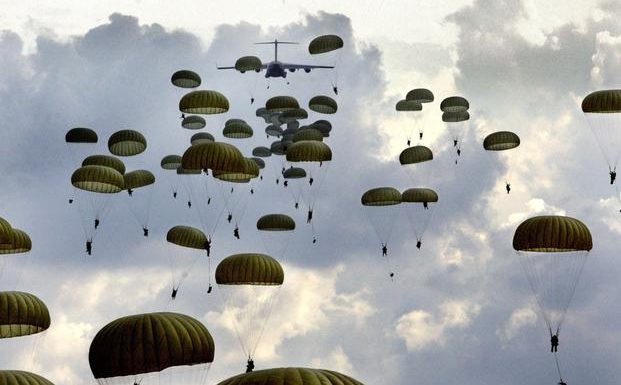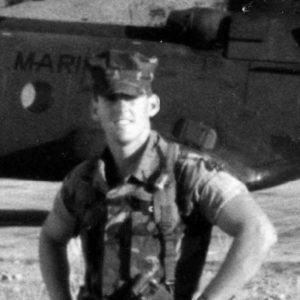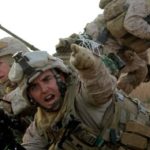
COMMEMORATING NATIONAL AIRBORNE DAY, AUGUST 16, 1940-2018
By W. Thomas Smith Jr.
 When I attended jump school nearly 40 years ago, there was a saying among non-paratroopers that ground week separated the men from the boys. Tower week separated the fools from the men. And during the third and final week, the fools jumped.
When I attended jump school nearly 40 years ago, there was a saying among non-paratroopers that ground week separated the men from the boys. Tower week separated the fools from the men. And during the third and final week, the fools jumped.
Of course, it was all light-hearted jabbing and a sincere bit of professional jealousy.
We knew then – as every soldier, sailor, airman, and Marine knows today – there is something special about a combat-trained parachutist or paratrooper, something uncommon that sets him apart from the ordinary foot-soldier.
Granted, jump school was not the toughest military training I would ever participate in: Though back then it wasn’t easy either. And it’s not simply the fact that a paratrooper (or military parachutist) jumps out of a perfectly good airplane – though not everyone has the physical courage to do that. But the “specialness” of a military parachutist rests within his willingness and ability to jump, and the fact that he will do so ready to fight, knowing full-well that he will probably be outnumbered by the enemy on the ground; certainly surrounded; and that his survival depends on his ability to catch the enemy by surprise; kill him, perhaps in close quarters; and continue to fight with limited food, equipment, and ammunition until he is reinforced by heavier ground units.
In fact, at least as far back as when I earned my wings, the initial perception of most anyone seeing a soldier (regardless of nation or service branch) wearing a badge, medal, or patch with a “parachute” might be that that he was or is “specially trained.” The second thought might be “he probably knows how to fight.”
In his book, Airborne: A Guided Tour of an Airborne Task Force, the late Tom Clancy wrote, “Most special forces claim a unique ethos. Many other branches of military service have tried to claim their own code: One that is special to them. Trust me: In most cases, the people doing the claiming are full of crap. In the whole of the American military, only a handful of groups are truly worthy of such a distinction – the Marine Corps, certain special forces units [Navy SEALs, Army Special Forces, Army Rangers, Air Force Special Tactics men, others] and of course, Airborne.”
Clancy was right. The American paratrooper was and is in many ways the epitome of the modern conventional warrior (if we can call him conventional): In order to be an Airborne soldier, one has to be fit and able to endure physical hardship beyond that required of an ordinary soldier. He must be able to fight with a variety of personal weapons as well as his bare hands. He must be courageous. And he must have a reasonable capacity to think on his own, outside of the box, and during periods of extreme stress.
In fact, in most cases, the very basic requirement of any “special operations” combatant is that he be first-and-foremost a sky soldier.
“Of course, parachuting is a means of delivery,” the late U.S. Army Lt. General John Bruce Blount, former chief of staff of Allied Forces Southern Europe, once told me. “Then you have to consider the types of people who make up Airborne units. They are young, fit, brave, willing to take a chance, and all of those things appeal to the special operations folks. Those characteristics are what special ops are looking for.”
Which brings us to August 16 – National Airborne Day – currently a marginally observed day that was decreed by presidential mandate in 2002.
For it was on the morning of August 16, 1940, that members of the Army’s brand new PARACHUTE TEST PLATOON began leaping from C-33 transports at an altitude of 1,500 feet over a recently cleared drop zone near Lawson Field at Fort Benning, Georgia.
First Lieutenant William T. Ryder jumped first, making him the first American soldier to jump from a plane. Second in the door was an anonymous enlisted soldier, so-paralyzed with fear, he was unable to jump. Next in line was Private William N. “Red” King, who would become the first enlisted soldier to jump.
Parachutes began to blossom over the Georgia countryside as one-by-one Ryder’s men stood in the door of the aircraft and waited for the leg slap and the “go” command from the Air Corps jump instructor (yes, it was initially an Air Corps project). The platoon made a second jump the next day.
Then, thanks to one of the test platoon members and a legendary Apache Indian chief, observers of the platoon’s third jump witnessed the birth of one of the great traditions of the American paratrooper: The jump cry or battle cry: “Geronimo!”
On the night prior to the jump, several members of the platoon were at the base theater watching a movie in which the warrior chief, Geronimo, and a band of his Apache braves were pursued by the U.S. Cavalry. Later, over a few beers, some of the men began teasing fellow trainee, Private Aubrey Eberhardt, saying that during the next day’s jump he would be too frightened to speak. Eberhardt boasted that he would not only speak, but shout the name of the great Indian warrior.
The following day, the six-foot-eight Eberhardt leapt from the plane yelling, “Geronimo!” He followed the shout with a war whoop so loud, soldiers on the ground could hear him. Other jumpers followed, also screaming the now-famous battle cry.
By September 1940, the Parachute Test Platoon would form the core of the new 501st Parachute Infantry Battalion, the first operational Airborne unit in American military history. But it was not the first time there had been any substantive consideration for establishing U.S. Airborne forces.
General Billy Mitchell actually proposed an Airborne assault operation during World War I. Mitchell’s plan called for strapping parachutes onto 12,000 select men of the 1st Infantry Division, the famous “Big Red One.” They would be loaded onto 1,200 British-built Handley-Page bi-winged bombers – ten men and two machineguns per plane – and dropped on the French city of Metz, a German stronghold deep behind enemy lines.
Enroute to the drop zone, the entire air fleet would be escorted by fighters, which would fly above, below, and on both flanks of the formation. Once safely on the ground, the paratroopers would assemble their weapons, reform into infantry units, and dig-in.
Overhead, Mitchell’s fighters would provide close air support until the paratroopers were sufficiently positioned behind their newly dug works and ready for action. With the paratroopers spreading panic and confusion in the German rear areas, the primary U.S. ground forces would climb out of their trenches and attack along a wide front. The plan proposed in October 1918, might have been carried out in the spring of 1919, but the war ended in November 1918.
In April 1940, during the initial stages of World War II, large numbers of German fallschirmjäger (literally, parachuting hunters) jumped over Norway and Denmark, seizing key bridges and military installations. Surprisingly, the attacks received little attention. This has since been attributed to the fact that a series of more dramatic Naval clashes took place off the Norwegian coast around the same time.
In May, the German Army crossed the borders of Holland, Belgium, and Luxembourg. The Nazis spearheaded their attacks with surprise Airborne and gliderborne assaults which confused and overwhelmed their enemies and shocked the world.
The effectiveness of the fallschirmjäger compelled the U.S. War Department to begin planning and crash-building their own Airborne forces. Thus, the Parachute Test Platoon.
U.S. paratroopers proved their mettle during the war, with Airborne forces ultimately swelling to five Army Airborne divisions – the 82nd, the 101st, the 11th, the 13th, and the 17th – several gliderborne units, even the Marine Corps’ short-lived Paramarines.
Over the next 70-plus years, U.S. paratroopers, military parachutists, and Airborne units would go through a number of evolutionary phases, downsizing, changing, yet performing magnificently in all of America’s war and military excursions.
Today, the Army’s Airborne strength has been reduced significantly to only a single division of paratroopers, the 82nd (the 101st is also designated “Airborne,” but it is in fact “air assault”), the 173rd Airborne Brigade, the 75th Ranger Regiment, and various smaller units. But combat trained parachutists also serve as the basic element of modern American special operations forces.
All services – Army, Navy, Marine Corps, Air Force, even the paramilitary elements within the Central Intelligence Agency – maintain airborne-qualified units or parachute elements. And nearly all paratroopers or combat parachutists, regardless of service branch, are initially trained at the U.S. Army’s “jump” school at Fort Benning. There is also advanced parachute training – HALO (high altitude low opening) and HAHO (high altitude high opening) – conducted by the Army as well as other service-branches in-house.
Airborne is a key component of all modern special operations and special warfare units. In fact, the very nature of a parachutist’s mission is special: Dropping behind an enemy’s lines is essentially an unconventional thus “special” operation. And the level of personal commitment and basic athleticism required of a paratrooper is a prerequisite for joining the ranks of special operations forces. Lastly, a paratrooper is not likely to be the kind of soldier who would fold under fire. The “airborne spirit” is a kind of ethos that when integrated with a soldier’s psyche practically ensures that he will fight, and fight well. And that is not some hollow rah-rah statement.
“The intangible but very real end product that stems from an individual’s evaluation of himself is perhaps the most precious result of the process that produces parachute soldiers,” the late Lt. General William Pelham “Bill” Yarborough, one of the “founding fathers” of both American Airborne and special operations forces, wrote in the foreword to Airborne by Edward M. Flanagan Jr. “A warrior who will bail out at night onto a battlefield deep in enemy country while carrying fifty pounds of equipment, weapons, and ammunition is not likely to perform poorly in combat.”
In his 2002 National Airborne Day proclamation, President George W. Bush said, “Airborne combat continues to be driven by the bravery and daring spirit of sky soldiers.”
So perhaps the fools do jump during the final week of parachute training. But it is the threat of those same fools which keeps America’s enemies wide awake at night – to piggyback on an old cliché – while the rest of us soundly sleep.
– Military technical consultant W. Thomas Smith Jr is a former U.S. Marine infantry leader and counterterrorism instructor. Visit him at http://uswriter.com.

